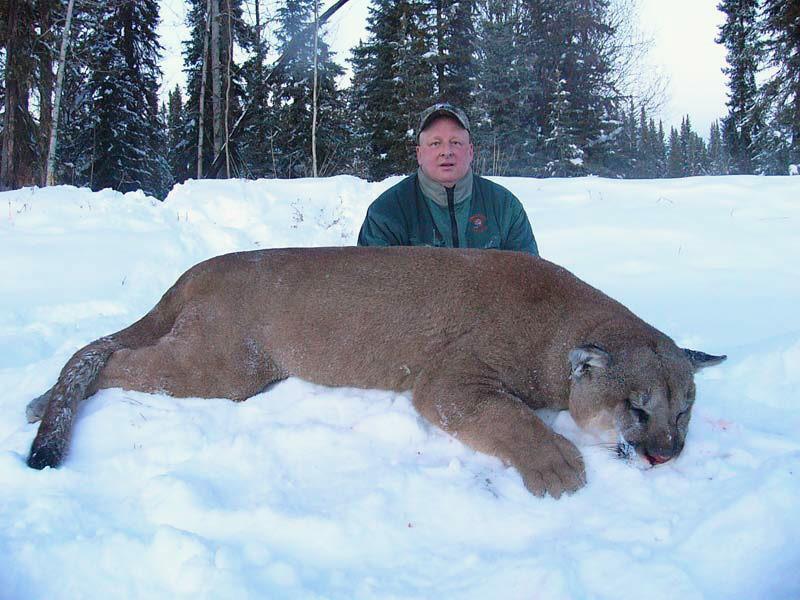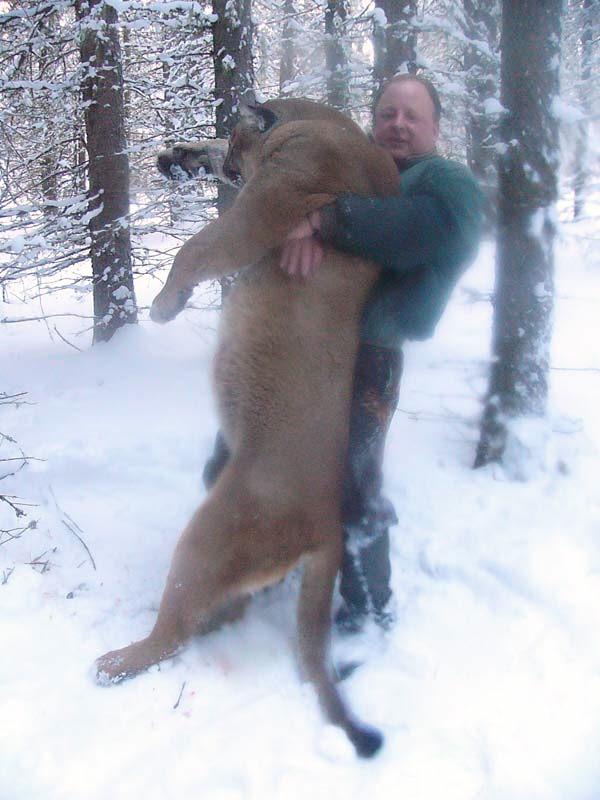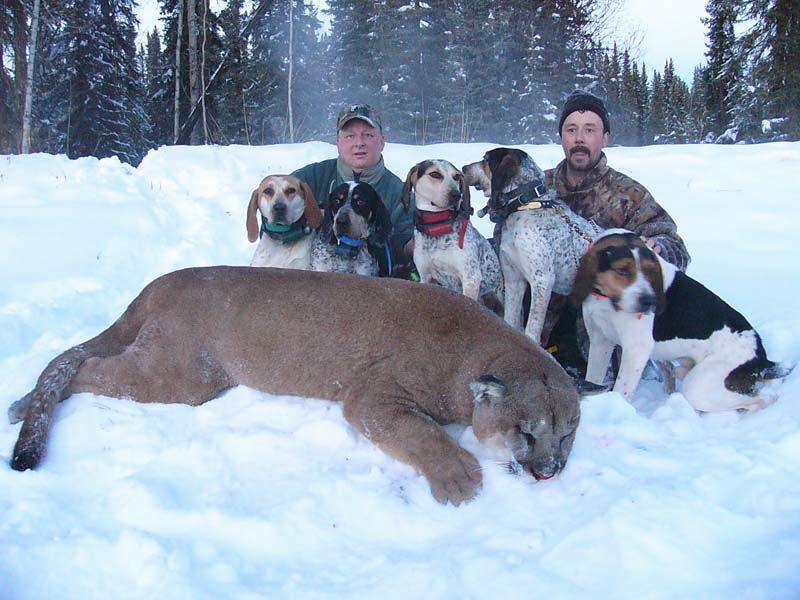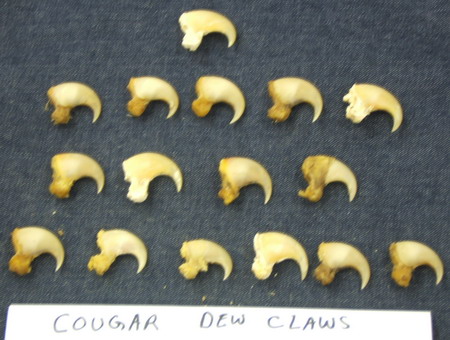Вы не зашли.
Объявление
"Давайте только проявлять больше внимания, терпимости и уважения к чужому мнению — вот и всё." — Gennadius.
— О размещении изображений на форуме, О рекламе на форуме
#151 11 December 2009 18:20:30
- ПуМкА Wildheart
- Любитель животных

- Зарегистрирован: 30 November 2009
- Сообщений: 274
Re: Пума, или кугуар (Puma concolor)
Персинваль :
P.S. О кулинарии. Кошки вообще вкусные, как говорят.
Орррр! *спряталась под диваном* Мы всёже не в Корее живём! Я из мяса ем тока курицу!
Мирационикс, почему "и даже белые"? Тем более белые - они вообще самые крупные и агрессивные среди медведей)
Осмыслевая мысль о смысле смысла имеет смысл помыслить о немыслемом...
Неактивен
#152 11 December 2009 19:14:30
- Miracinonyx
- Любитель животных

- Зарегистрирован: 05 December 2006
- Сообщений: 19226
Re: Пума, или кугуар (Puma concolor)
Нет, нет, Пумка, они облигатные хищники, но не самые агрессивные, далеко. бурый медведь опаснее и для себе подобных, и для людей, чем белые. Но это оффттоп!
Неактивен
#153 11 December 2009 19:18:52
- ПуМкА Wildheart
- Любитель животных

- Зарегистрирован: 30 November 2009
- Сообщений: 274
Re: Пума, или кугуар (Puma concolor)
оффтоп: в каком смысле - "облегатные"?
Осмыслевая мысль о смысле смысла имеет смысл помыслить о немыслемом...
Неактивен
#154 11 December 2009 19:22:19
- Miracinonyx
- Любитель животных

- Зарегистрирован: 05 December 2006
- Сообщений: 19226
Re: Пума, или кугуар (Puma concolor)
"и" ![]() - значит, "обязательные", не способные обходиться другими видами кормов. Пума - облигатный мясоед. А енот и барибал - нет, они могут жить и без мяса (хотя иногда оно им нужно, но не составляет основного массива кормов).
- значит, "обязательные", не способные обходиться другими видами кормов. Пума - облигатный мясоед. А енот и барибал - нет, они могут жить и без мяса (хотя иногда оно им нужно, но не составляет основного массива кормов).
Неактивен
#155 14 December 2009 15:02:04
- Персинваль
- Советник

- Откуда: Санкт-Петербург
- Зарегистрирован: 25 November 2006
- Сообщений: 1183
- Вебсайт
Re: Пума, или кугуар (Puma concolor)
ПуМкА Wildheart :
Орррр! *спряталась под диваном*
Сам не пробовал, но так говорят.
P.S. Кошачья "мораль" не запрещает при необходимости есть своих же мертвых сородичей. С другой стороны, убийство вне агрессии и поедание в живую уже запрещено. Т.е. если самка с котятами (которым, предположим, год) попадет в капкан, то она не съест детенышей и не откусит себе лапу, но, после её смерти, котята могут её съесть.
P.P.S. Диван не большой, лучше за ним.
Неактивен
#156 17 December 2009 10:45:22
- Jerry
- Любитель животных

- Откуда: Башкортостан
- Зарегистрирован: 15 June 2008
- Сообщений: 314
Re: Пума, или кугуар (Puma concolor)
Значит и у них встречается каннибализм.
Неактивен
#157 28 December 2009 02:37:02
- Crazy Zoologist
- Гость
Re: Пума, или кугуар (Puma concolor)
О пумах:
http://dspace.nitle.org/bitstream/handl … sequence=1
http://www.scielo.br/pdf/gmb/v29n2/a17v29n2.pdf генетика пумы, ягуарунди и ягуара.
http://www.auburn.edu/cosam/departments … estAge.pdf о черепах
#158 30 December 2009 03:41:15
- Crazy Zoologist
- Гость
Re: Пума, или кугуар (Puma concolor)
Cougars have large paws and proportionally the largest hind legs in the cat family.[19] This physique allows it great leaping and short-sprint ability. An exceptional vertical leap of 5.4 m (18 ft) is reported for the cougar.[27] Horizontal jumping capability from standing position is suggested anywhere from 6 to 12 m (20 to 40 ft). The cougar can run as fast as 55 to 72 km/h (35 to 45 mi/h),[28] but is best adapted for short, powerful sprints rather than long chases. It is adept at climbing, which allows it to evade canine competitors. Although it is not strongly associated with water, it can swim.
Пума, весом более 90 кг.


Когти.
#159 03 January 2010 13:32:11
- Crazy Zoologist
- Гость
Re: Пума, или кугуар (Puma concolor)
A successful generalist predator, the cougar will eat any animal it can catch, from insects to large ungulates (over 500 kg). Like all cats, it is an obligate carnivore, feeding only on meat. The Mean weight of vertebrate prey (MWVP) was positively correlated (r=0.875) with puma body weight and inversely correlated (r=-0.836) with food niche breadth in all America. In general, MWVP was lower in areas closer to the Equator.[3] Its most important prey species are various deer species, particularly in North America; mule deer, white-tailed deer, elk, and even large moose are taken by the cat. Other species such as Bighorn Sheep, wild horses of Arizona, domestic horses, and domestic livestock such as cattle and sheep are also primary food bases in many areas.[30] A survey of North America research found 68% of prey items were ungulates, especially deer. Only the Florida Panther showed variation, often preferring feral hogs and armadillos.[3]
Investigation in Yellowstone National Park showed that elk, followed by mule deer, were the cougar's primary targets; the prey base is shared with the park's gray wolves, with whom the cougar competes for resources.[31] Another study on winter kills (November–April) in Alberta showed that ungulates accounted for greater than 99% of the cougar diet. Learned, individual prey recognition was observed, as some cougars rarely killed bighorn sheep, while others relied heavily on the species.[32]
In the Central and South American cougar range, the ratio of deer in the diet declines. Small to mid-size mammals are preferred, including large rodents such as the capybara. Ungulates accounted for only 35% of prey items in one survey, approximately half that of North America. Competition with the larger jaguar has been suggested for the decline in the size of prey items.[3] Other listed prey species of the cougar include mice, porcupine, and hares. Birds and small reptiles are sometimes preyed upon in the south, but this is rarely recorded in North America.[3]
Though capable of sprinting, the cougar is typically an ambush predator. It stalks through brush and trees, across ledges, or other covered spots, before delivering a powerful leap onto the back of its prey and a suffocating neck bite. The cougar is capable of breaking the neck of some of its smaller prey with a strong bite and momentum bearing the animal to the ground.[22]
Kills are generally estimated at around one large ungulate every two weeks. The period shrinks for females raising young, and may be as short as one kill every three days when cubs are nearly mature at around 15 months.[19] The cat drags a kill to a preferred spot, covers it with brush, and returns to feed over a period of days. It is generally reported that the cougar is a non-scavenger and will rarely consume prey it has not killed; but deer carcasses left exposed for study were scavenged by cougars in California, suggesting more opportunistic behavior.[33]
(с) Википедия.
Надо же, и на мустангов, оказывается, нападает!
The cougar, the largest wild cat native to British Columbia, is an imposing but evasive member of our wildlife. His secretive habits, and sometimes astounding predatory abilities (the cougar is capable of killing a 600 pound moose or elk), have resulted in a wealth of human misconceptions and irrational fears. In some instances, "control" programmes responding to these fears placed severe and unwarranted hunting pressure upon cougar populations.
The adult cougar is a large animal: the heaviest recorded was an Arizona cougar which weighed 276 pounds. Although there have been several cougar taken in British Columbia weighing between 190 and 210 pounds, the average adult male weighs about 125 pounds and the female 100 pounds. Large adult males may measure 9 feet in length, including a 30-inch tail.
The predatory activities of the cougar are legendary, and prey species in British Columbia range from large animals to mice, and include deer, porcupine, beaver, varying hare, moose, elk, wild sheep, mountain goats, black bear (cubs), grouse, coyote, other cougar, domestic stock, and household pets.
The cougar is, in part, an opportunist when looking for food. A study of the winter food habits of cougar in south-central British Columbia concluded that mule deer was the staple winter food, but a variety of other species were taken. When a population of varying hare was at a peak the hare were preyed upon frequently, domestic stock, when available, were eaten, as were moose. Adult mule deer bucks (1 1/2 years and older) were selected over anterless mule deer, and, in general, very old animals were taken by cougar in a greater proportion than were represented in the mule deer population.
There are few authentic instances of cougar attacking humans. Normal behaviour is one of human avoidance, although cougar often displays a harmless curiosity toward the actions of man. They have been observed sitting at a vantage point and watching, sometimes for hours, people either working or playing out of doors. Hunters, and others, have reported the tracks of a cougar following their own in the snow. The infrequent attacks on humans are usually attributed to old, starving cougar, or to cougar which are defending their young.
When hunting the larger ungulates, cougar do not crouch over or near a game trail waiting for the unsuspecting prey to pass nearby. The kill is usually made following a careful stalk of the intended victim. Cougar hunters have observed that cats must make a kill within two or three jumps, usually 20 to 50 feet after their stalk. If the prey escapes, the cougar will rarely follow, and the stalk will be repeated upon a different animal. The kill follows a sudden leap from the ground onto the shoulders and neck of the prey. The most effective kills are made when the cougar holds the head with a forepaw and bites down through the back of the neck, near the base of the skull.
Kills are not always quick or successful and the larger prey, particularly large elk, moose, or deer, will struggle violently to escape. Instances where cougar have been seriously hurt following such encounters are infrequent, but not unheard-of.
Porcupine, despite their troublesome quills, are not an insurmountable obstacle to a cougar. Cougar tend to avoid the quills by flipping the porcupine on its back and eating the underparts first. It is not necessary however, to eat the flesh only, as cougar stomachs containing quills in varying stages of digestion have been encountered. There appears to be little ill-effect from these quills, although single quill may puncture the stomach wall and work into the abdominal cavity. Cougar are frequently found with quills in their paws and around the face, but these apparently are either pulled out, fall out, or, if they work under the skin, eventually dissolve.
Wasteful behaviour in the killing of prey is the exception and not the rule. Cougar generally eat about 70 per cent (by weight) of the carcass of a big-game animal, leaving most of the larger skeletal bones, the rumen, some viscera, and parts of the hide. They will make repeated visits to a carcass, take a meal during each visit, and usually cover the remains with dirt and debris after each feed.
Although there have been observations where a single cougar has killed several deer, domestic sheep, etc., at one time, detailed studies have shown an adult cougar needs no more than 14 to 20 average-sized mule deer per year. This will be less if the diet is supplemented by other foods.
Статья полностью - http://www.env.gov.bc.ca/wld/documents/cougar.htm (Cougar in British Columbia).
Отредактировано Crazy Zoologist (03 January 2010 13:38:32)
#160 03 January 2010 13:50:32
- Miracinonyx
- Любитель животных

- Зарегистрирован: 05 December 2006
- Сообщений: 19226
Re: Пума, или кугуар (Puma concolor)
Конечно нападает на мустангов - при сравнении частот нападения на одинаково доступную добычу прояснилось, что у пум явное предпочтение к лошадиному мясу перед любым другим. Кстати, у большинство кошек, кто живет в ареале обитания лошадей и достаточно силен для их добычи - тоже так. Так что истребление американских автохтонных видов лошадиных нанесло пумам серьезный гастрономический урон в свое время.
Неактивен
#161 03 January 2010 13:58:31
- Crazy Zoologist
- Гость
Re: Пума, или кугуар (Puma concolor)
Наверное трудно им охотиться на мустангов. Они быстры (хоть и не так быстры как пума), очень выносливы, очень чутки и сильны. И они поумнее оленей и полорогих. Хотя даже самая сильная лошадь наверное ничего не сможет противопоставить крупной пуме...
#162 03 January 2010 14:28:20
- Miracinonyx
- Любитель животных

- Зарегистрирован: 05 December 2006
- Сообщений: 19226
Re: Пума, или кугуар (Puma concolor)
Ну да... кошка такого размера и ловкости, как пума - это не волк... От нее зубами и копытами особо не отобьешься... Только убегать из-зо всех сил, а ведь не всегда успеешь...
Неактивен
#163 06 January 2010 10:35:24
- Jerry
- Любитель животных

- Откуда: Башкортостан
- Зарегистрирован: 15 June 2008
- Сообщений: 314
Re: Пума, или кугуар (Puma concolor)
Но даже для такой сильной кошки мустанг очень силен.
Неактивен
#164 06 January 2010 11:29:18
- Crazy Zoologist
- Гость
Re: Пума, или кугуар (Puma concolor)
Да хоть тяжеловоз. Он ничего ей противопоставить не может. Единственная сложность - задушить лошадь, пуме придётся постараться. Ни укусить, ни ударить копытами лошади не удасться.
#165 08 January 2010 16:46:23
- Jerry
- Любитель животных

- Откуда: Башкортостан
- Зарегистрирован: 15 June 2008
- Сообщений: 314
Re: Пума, или кугуар (Puma concolor)
Ну это да,только если произойдет случайность,тогда будет плохо,а так...
Неактивен
#166 08 January 2010 17:35:27
- Miracinonyx
- Любитель животных

- Зарегистрирован: 05 December 2006
- Сообщений: 19226
Re: Пума, или кугуар (Puma concolor)
В принципе, лошадь лягнуть может и должна, конечно. Просто пума не львица. Тупо бежать сзади и попадать под удар задних ног она вряд ли будет. А если при боковой атаке пума успеет вспрыгнуть лошади на спину - то всё, шансов практически нет. Хотя лошади умеют скидывать хищника и со спины, они катаются. Вообще обороняются гораздо лучше других копытных, хотя ни рогов, ни веса нет.
Неактивен
#167 14 January 2010 19:33:50
- Crazy Zoologist
- Гость
Re: Пума, или кугуар (Puma concolor)
Пума завалила огромного вапити с рогами (фотки) - http://www.carnivoraforum.com/index.cgi … hread=2623
#168 14 January 2010 23:00:09
- Crazy Zoologist
- Гость
Re: Пума, или кугуар (Puma concolor)
Мул убил пуму!!! Фотки и текст - http://www.blackbearheaven.com/horse-kills-cougar.htm
#169 15 January 2010 10:10:55
- Hardcorp
- Любознательный
- Откуда: Питер
- Зарегистрирован: 28 February 2009
- Сообщений: 216
Re: Пума, или кугуар (Puma concolor)
Crazy Zoologist :
Пума завалила огромного вапити с рогами
В том-то и дело, что не завалила. Случай, кстати, очень показательный и подтверждает высказанные сомнения. Пума просто не смогла его задушить, слишком маленькие и слабые челюсти, слишком короткие клыки, недостаточно выносливости. Применить метод прокусывания шейных позвонков она тоже вряд ли смогла бы, по той же причине, чай, не тигр. И это при том, что вапити завяз в снегу!
Второй случай из той же оперы. Конечно, пума не из крупных подвидов, но и лошадь тоже не мустанг. Так что разница в размерах в любом случае впечатляет.
Неактивен
#170 15 January 2010 14:59:06
- Miracinonyx
- Любитель животных

- Зарегистрирован: 05 December 2006
- Сообщений: 19226
Re: Пума, или кугуар (Puma concolor)
Круто! Вот это мул!!! Кстати, по фото видно, насколько маленький у пумы череп по сравнению с размерами шеи и головы мула.
Неактивен
#171 16 January 2010 18:36:18
- Jerry
- Любитель животных

- Откуда: Башкортостан
- Зарегистрирован: 15 June 2008
- Сообщений: 314
Re: Пума, или кугуар (Puma concolor)
Так что мустанг очень даже может убить пуму если повезет.
Неактивен
#172 16 January 2010 19:15:32
- Crazy Zoologist
- Гость
Re: Пума, или кугуар (Puma concolor)
Если повезёт и человек может убить пуму.
#173 16 January 2010 19:42:59
- Jerry
- Любитель животных

- Откуда: Башкортостан
- Зарегистрирован: 15 June 2008
- Сообщений: 314
Re: Пума, или кугуар (Puma concolor)
Интересно как?Задушить как псового не получится,пума обхватит лапами и начнет брыкаться задними ногами,с удара вырубить врядли получится,у кошачьих реакция супер.
Неактивен
#174 16 January 2010 19:57:09
- Crazy Zoologist
- Гость
Re: Пума, или кугуар (Puma concolor)
А у коня реакция много хуже чем у человека, и сбросить лошади пума ткже сложнее, но тем не менее лошадь если повезёт может убить пуму. Так и человек тоже.
#175 16 January 2010 21:43:48
- Crazy Zoologist
- Гость
Re: Пума, или кугуар (Puma concolor)
Самка пумы атакует толсторога. Посмертно.